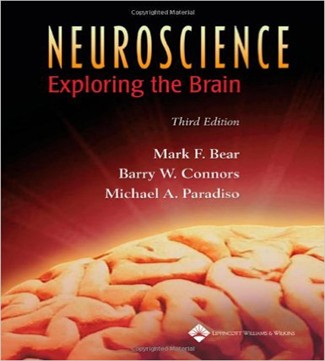Neuroscience Exploring the Brain 3rd Edition Bear Connors Paradiso Test Bank
$35.00
Neuroscience Exploring the Brain 3rd Edition Bear Connors Paradiso Test Bank
ISBN-10: 0781760038
ISBN-13: 9780781760034 978-0781760034
1. A simple reflex requires the nervous system to perform three functions. Two of these functions are to collect and distribute information. What is the third function? Choose the correct option.
A) Disintegrate information C) Process information
B) Integrate information D) Translate information
Ans: B
Difficulty: Easy
2. What is resting membrane potential? Choose the correct option.
A) Difference in electrical charge across the membrane at rest
B) Generation and conduction of action potential at rest
C) Positive charge inside the membrane with respect to outside at rest
D) Isolation of the cytosol from extracellular fluid
Ans: A
Difficulty: Moderate
3. What is capacitance? Choose the correct option.
A) Electrical potential difference C) Voltage across neuronal membrane
B) Storage of electric charge D) Migration of electric charge
Ans: B
Difficulty: Difficult
4. Which of the following is the major charge carriers involved in the conduction of electricity in neurons? Choose the correct option.
A) Anions B) Cations C) Ions D) Ionic bonds
Ans: C
Difficulty: Easy
5. How do the lipids of the neuronal membrane contribute to the neuronal membrane potential? Choose the correct option.
A) Encourages chemical interactions with water
B) Catalyzes chemical reactions
C) Integrates cytosol of neuron with extracellular fluid
D) Forms a barrier to water-soluble ions and water
Ans: D
Difficulty: Moderate
6. Which force other than the ionic concentration gradient determines the equilibrium potential for an ion? Choose the correct option.
A) Selective ionic permeability C) Electrical resistance
B) Sodium potassium pump D) Electrical conductance
Ans: A
Difficulty: Easy
7. How do action potentials differ from passively conducted electrical signals? Choose the correct option.
A) Action potentials diminish over distance; passively conducted signals do not diminish over distance
B) Action potentials occur only in nerve cells; passively conducted signals occur only in muscle cells
C) Action potentials are transmitted over short distances; passively conducted signals are conducted over long distances
D) Action potentials are signals of fixed size and duration; passively conducted signals are not signals of fixed size and duration
Ans: D
Difficulty: Easy
8. How does the sodium potassium pump help maintain the resting membrane potential? Choose the correct option.
A) Pumps potassium in and sodium out
B) Pumps sodium in and potassium out
C) Exchanges a sodium and a potassium for a calcium
D) Uses calcium to pump sodium and potassium against their concentration gradients
Ans: A
Difficulty: Easy
9. Which of the following mechanisms decrease intracellular [Ca2+]? Choose the correct option.
A) The calcium pump
B) Intracellular calcium-binding proteins
C) Organelles such as mitochondria and endoplasmic reticulum
D) All of the above
Ans: D
Difficulty: Easy
10. What is the meaning of an ion’s equilibrium potential? Choose the correct option.
A) Net movement of ions from a region of high concentration to a region of low concentration
B) Electrical potential difference that exactly balances an ionic concentration gradient
C) Difference between the real membrane potential and equilibrium potential for a particular ion
D) Difference in concentration between region with high ionic concentration and region with low ionic concentration
Ans: B
Difficulty: Moderate
11. What is the term used to describe the mechanism for the regulation of [K+]o by astrocytes? Choose the correct option.
A) Depolarization C) Blood-brain barrier
B) Potassium spatial buffering D) Goldman equation
Ans: B
Difficulty: Moderate
12. Distinguish between the “head” and “tail” of phospholipids. Choose the correct option.
A) The phospholipids have a nonpolar “head” and polar “tail.”
B) The phospholipids “head” contains hydrophilic phosphate and “tail” contains a hydrophobic hydrocarbon.
C) The phospholipid “head” is hydrophobic and the hydrocarbon “tail” is hydrophilic.
D) The phospholipid “heads” face each other and “tails” face the watery extracellular and intracellular environments.
Ans: B
Difficulty: Easy
13. In which condition do astrocytes take up extracellular K+? Choose the correct option.
A) Rise in extracellular potassium concentrations
B) Fall in extracellular potassium concentrations
C) Potassium equilibrium potential
D) All of the above
Ans: A
Difficulty: Difficult
14. Which of the following factors determines the ion selectivity of specific ion channels? Choose the correct option.
A) Number of protein molecules assembling to form a pore
B) Number of ion channels in the membrane
C) Nature of the R groups lining the ion channel
D) Gating properties
Ans: C
Difficulty: Easy
15. Two types of cells have excitable membranes, neurons and muscle cells.
Ans: True
Difficulty: Easy
16. Protein shape influences protein function.
Ans: True
Difficulty: Easy
17. Peptide bonds are a single chain of amino acids.
Ans: False
Difficulty: Easy
18. The differences between amino acids result from the differences in the size and nature of the R groups.
Ans: True
Difficulty: Easy
19. The subunits of different potassium channels have common structural features that bestow selectivity for K+ ions. ______________ is one such structural feature.
Ans: Pore loop
Difficulty: Easy
20. All amino acids have a central _________ atom.
Ans: Alpha carbon
Difficulty: Easy












Reviews
There are no reviews yet.